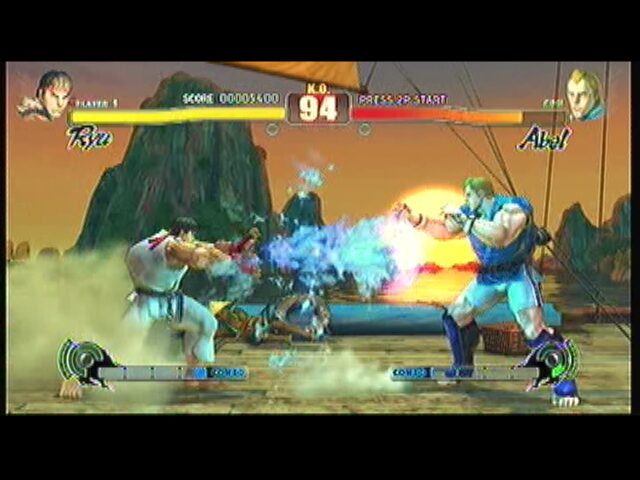Retro Replay Review
Gameplay
Street Fighter IV revives the classic six-button control scheme that fans of Super Street Fighter II Turbo and Street Fighter III: 3rd Strike will instantly recognize. Light, medium and heavy punches and kicks form the backbone of the combat, while throws, quick stands and dashes add nuance to footsies and spacing. Combos feel responsive and precise, rewarding timing and strategic planning over mindless inputs.
(HEY YOU!! We hope you enjoy! We try not to run ads. So basically, this is a very expensive hobby running this site. Please consider joining us for updates, forums, and more. Network w/ us to make some cash or friends while retro gaming, and you can win some free retro games for posting. Okay, carry on 👍)
A major innovation in this installment is the Focus Attack system, which lets you absorb an incoming strike and counterattack in one fluid motion. By holding two punches or kicks, your character enters a Focus stance: if you connect, you can cancel into further moves or use a dash cancel for extended combos. This mechanic shifts the emphasis from memorizing long sequences to reading your opponent’s intentions.
Street Fighter IV also reintroduces Super Combos via a gauge that fills as you land hits and take damage. When full, you can unleash devastating Super arts, and when your revenge gauge is maxed, an Ultra Combo—complete with a dramatic cinematic camera—can turn the tide of battle. These elements layer strategic resource management atop the classic punch-kick framework.
The console and PC versions expand on the arcade foundation with extensive features. Online multiplayer delivers ranked and casual matchups, while downloadable content adds new characters like Crimson Viper, Abel and El Fuerte. Modes such as Challenge, Training, and Bonus Stages help newcomers learn the basics, and animated intros and endings deepen the single-player package.
Graphics
Street Fighter IV adopts a striking hybrid style: stages are confined to traditional 2D planes, but characters are modeled in full 3D polygons. This choice preserves the series’ roots in old-school competitive gameplay while allowing for dynamic camera work and dramatic effects during special moves.
The character models stand out thanks to an art direction that mimics ink and paint strokes, giving each fighter a hand-drawn flair. Muscular details, costume textures and even facial expressions benefit from this stylized approach, making Ryu’s gi or Chun-Li’s cheongsam feel tactile and expressive.
Backgrounds are richly detailed, ranging from neon-lit Tokyo streets to dusty Mexican arenas. Subtle animations—like fluttering banners, roaming wildlife or cheering crowds—lend life to every match. When an Ultra Combo hits, the camera pulls in for a close-up, heightening the drama with particle effects and slow-motion flair.
Overall, SF IV’s visuals strike a balance between readability and spectacle. Health bars, stun meters and combo counters remain clear, ensuring that competitive integrity coexists with eye-catching presentation. Even on standard HDTVs or older PCs, the game maintains smooth frame rates essential for high-level play.
Story
Set chronologically between the events of Street Fighter II and Street Fighter III, SF IV weaves together the fates of a global roster. Ryu continues his quest for self-improvement, while Ken hones his Shoto style under the watchful eye of long-lost master Gouken. Returning rivals like Sagat, M. Bison and Chun-Li each face new challenges that tie into an undercurrent of rising bioweapon experiments.
The narrative centerpiece is the emergence of Seth, a mysterious new boss character who wields stolen techniques from all fighters. His morphing limbs and unpredictable moveset offer a tangible threat that unites old enemies in common cause. As players progress through Arcade Mode, animated intros and endings flesh out individual motivations and rivalries.
While the story isn’t as deep as a dedicated RPG, the inclusion of fully voiced sequences—available in both Japanese and English—adds personality to each protagonist. Secret encounters with Gouken and hidden boss battles deepen lore for series veterans, while newcomers appreciate concise introductions to each fighter’s background.
Ultimately, Street Fighter IV delivers enough narrative context to drive single-player engagement without slowing down the core fighting experience. The story complements, rather than overshadows, the arcade and versus battles that made the franchise legendary.
Overall Experience
Combining time-tested mechanics with modern design flourishes, Street Fighter IV feels both familiar and fresh. The learning curve accommodates newcomers through Challenge and Training modes, while the inclusion of focus attacks and Ultra Combos gives seasoned players new layers of depth to explore.
The audio-visual package elevates every match: sharp character animations, dynamic cameras and a pulse-pounding soundtrack keep adrenaline levels high. Minor load times between rounds are offset by colorful stage transitions and character banter, ensuring the pace rarely feels interrupted.
With local and online multiplayer, downloadable content, scoring leaderboards and a robust competitive scene, SF IV has tremendous longevity. Whether you’re perfecting punishes in offline Versus mode or climbing the worldwide ranks, there’s always a new challenge to tackle.
For anyone seeking a fighting game that balances accessibility, depth and style, Street Fighter IV remains an essential addition to the library. Its blend of classic mechanics, inventive new systems and compelling presentation make it a standout entry in one of gaming’s most enduring franchises.
 Retro Replay Retro Replay gaming reviews, news, emulation, geek stuff and more!
Retro Replay Retro Replay gaming reviews, news, emulation, geek stuff and more!









Reviews
There are no reviews yet.